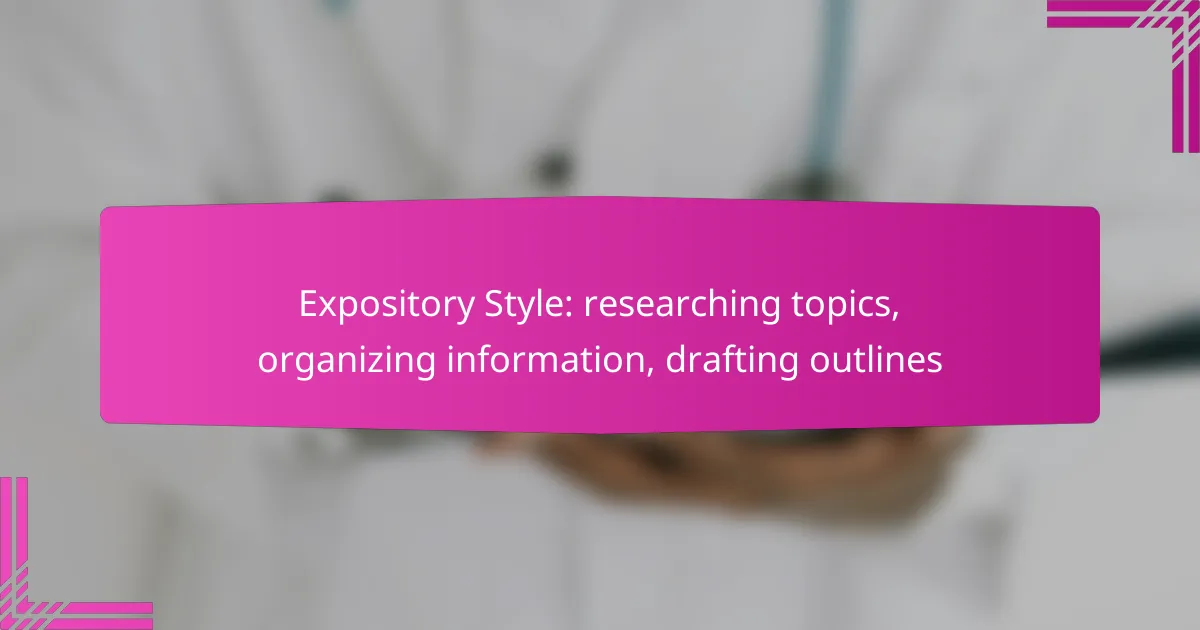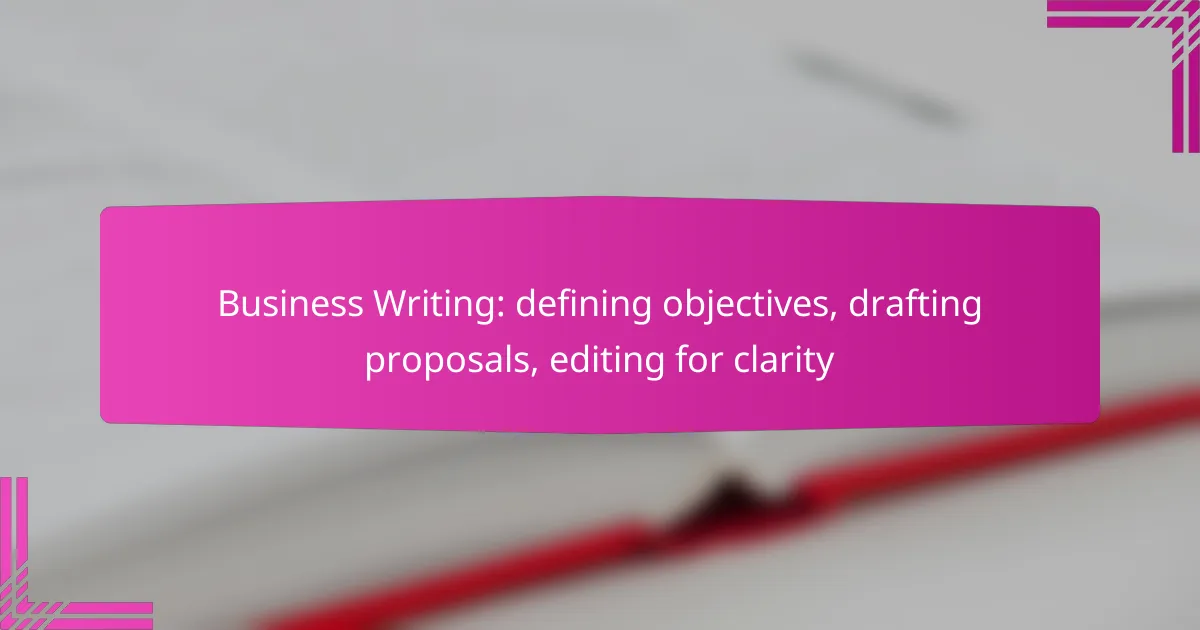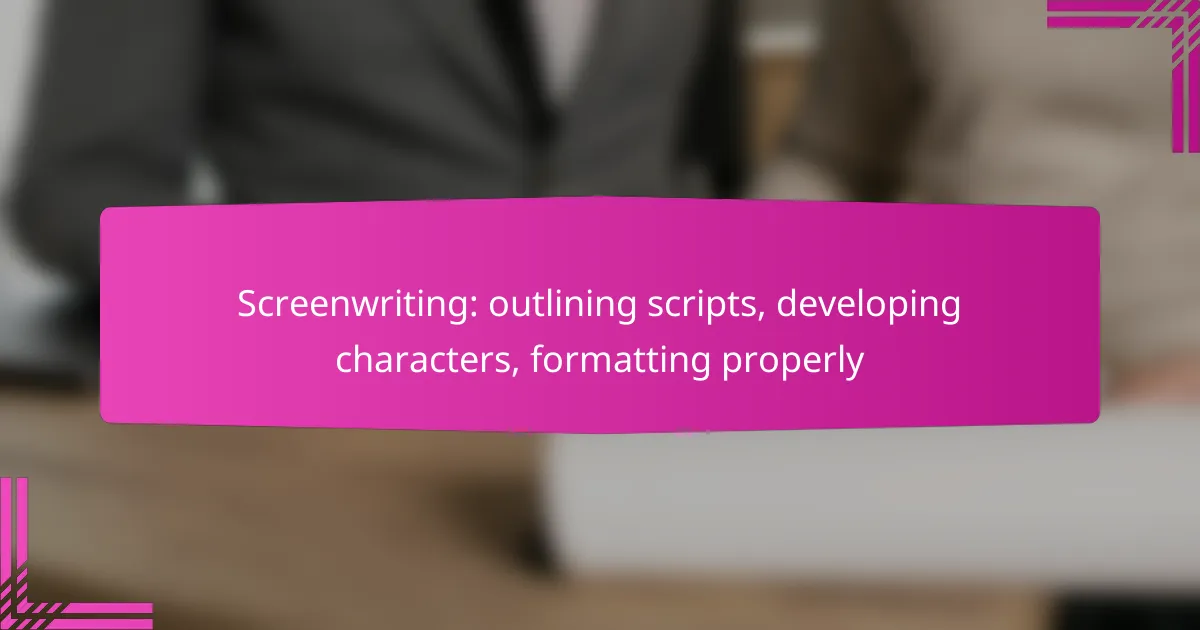Researching topics effectively requires a strategic approach to gather comprehensive information from various resources. Organizing this information enhances clarity and accessibility, while drafting outlines ensures that your writing is coherent and effectively communicates your message. By employing these techniques, you can create well-structured expository content that engages your audience.
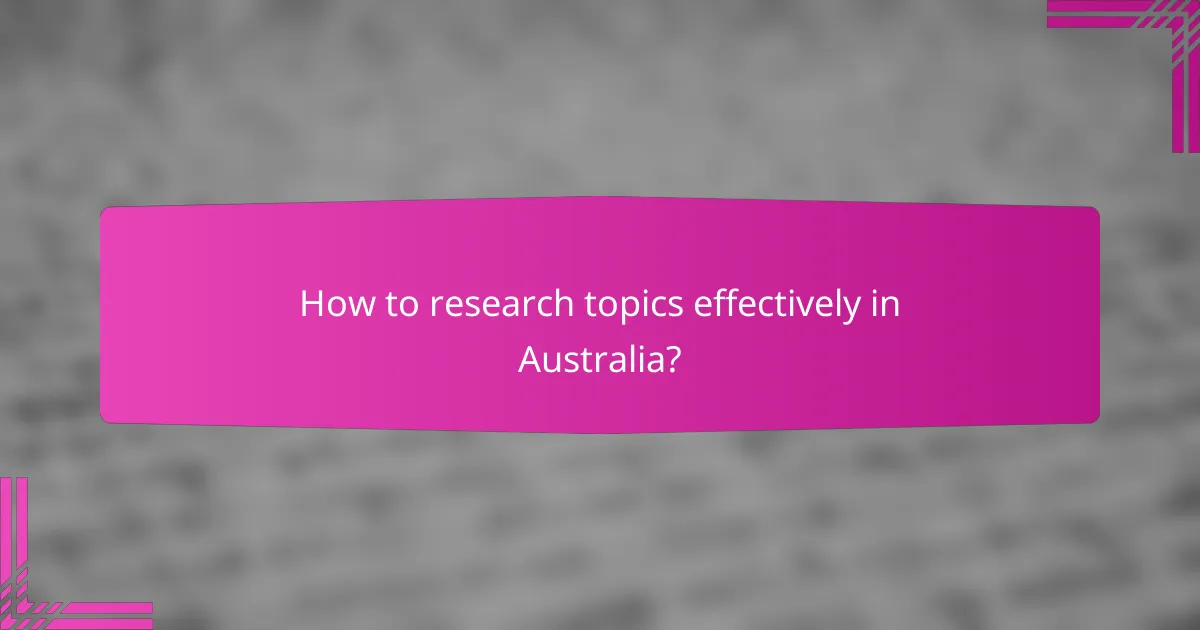
How to research topics effectively in Australia?
Effective research in Australia involves utilizing various resources to gather comprehensive information. Key strategies include accessing academic databases, leveraging Google Scholar, engaging with local libraries, and exploring Australian news outlets.
Utilize academic databases
Academic databases are essential for finding peer-reviewed articles, theses, and research papers relevant to your topic. In Australia, platforms like JSTOR, ProQuest, and the Australian National Data Service provide extensive collections of scholarly materials.
When using these databases, focus on keywords related to your topic to refine your search. Consider setting filters for publication dates to ensure you access the most current research.
Leverage Google Scholar
Google Scholar is a powerful tool for accessing a wide range of academic literature, including articles, theses, and conference papers. It allows you to search for scholarly articles across various disciplines, making it a versatile resource.
To maximize your use of Google Scholar, create alerts for specific topics or authors. This way, you can stay updated on new publications that align with your research interests.
Engage with local libraries
Local libraries in Australia, such as the State Library of New South Wales or the National Library of Australia, offer valuable resources for research. They provide access to physical books, journals, and digital collections that may not be available online.
Take advantage of library services like interlibrary loans and research assistance from librarians. They can guide you in finding specialized materials or databases tailored to your research needs.
Explore Australian news outlets
Australian news outlets, such as ABC News, The Sydney Morning Herald, and The Guardian Australia, are excellent sources for current events and public opinion on various topics. They can provide context and contemporary perspectives that enrich your research.
When using news sources, verify the credibility of the information and consider the publication date to ensure relevance. Look for articles that cite studies or expert opinions to support your findings.
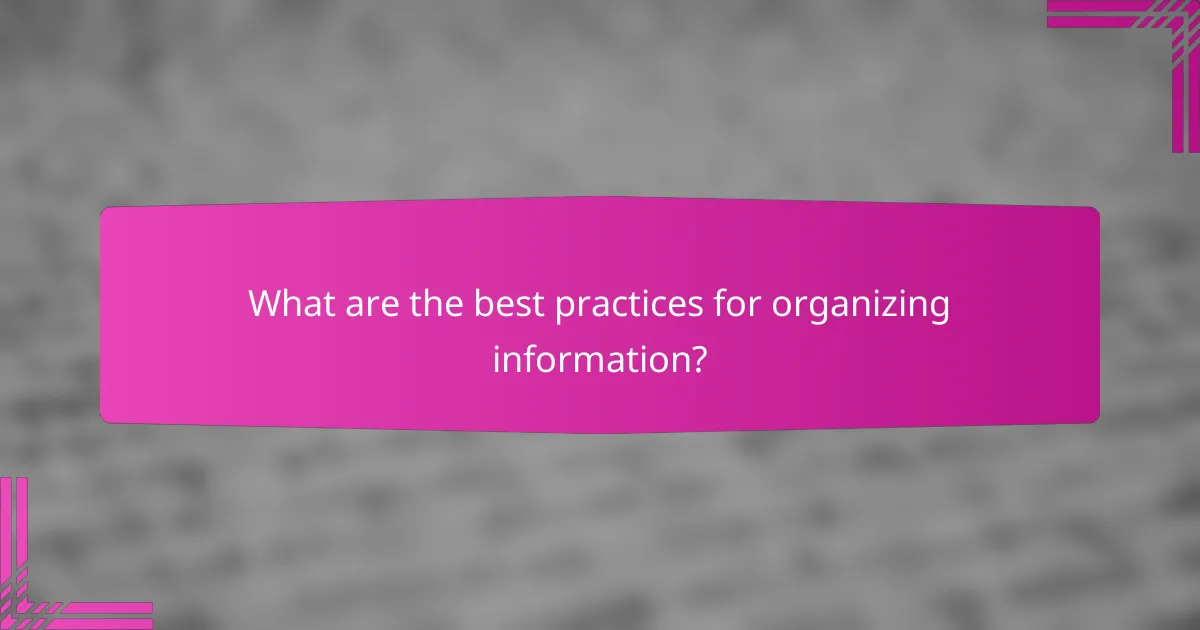
What are the best practices for organizing information?
Effective organization of information enhances clarity and accessibility. Best practices include using visual tools, structured formats, and digital applications to streamline the process.
Use mind mapping tools
Mind mapping tools help visualize relationships between concepts, making it easier to organize information. These tools allow users to create diagrams that connect ideas in a non-linear fashion, which can stimulate creativity and enhance understanding.
Popular mind mapping software includes XMind and MindMeister, which offer features like drag-and-drop functionality and collaboration options. When using mind maps, start with a central idea and branch out into subtopics, ensuring a clear hierarchy of information.
Implement hierarchical structures
Hierarchical structures organize information in a top-down format, which is effective for clarity and navigation. This approach involves categorizing data into main topics and subtopics, making it easier to locate specific information.
For example, in a research paper, the main sections could include Introduction, Methodology, Results, and Conclusion, with each section further divided into relevant subsections. This structure not only aids in comprehension but also helps in maintaining a logical flow throughout the document.
Adopt digital note-taking apps
Digital note-taking apps streamline the process of organizing information by allowing users to capture and categorize notes efficiently. Applications like Evernote and Notion offer features such as tagging, search functions, and templates to enhance organization.
When using these apps, create notebooks for different topics and use tags for easy retrieval. Regularly review and update your notes to keep the information relevant and organized, avoiding clutter and confusion.
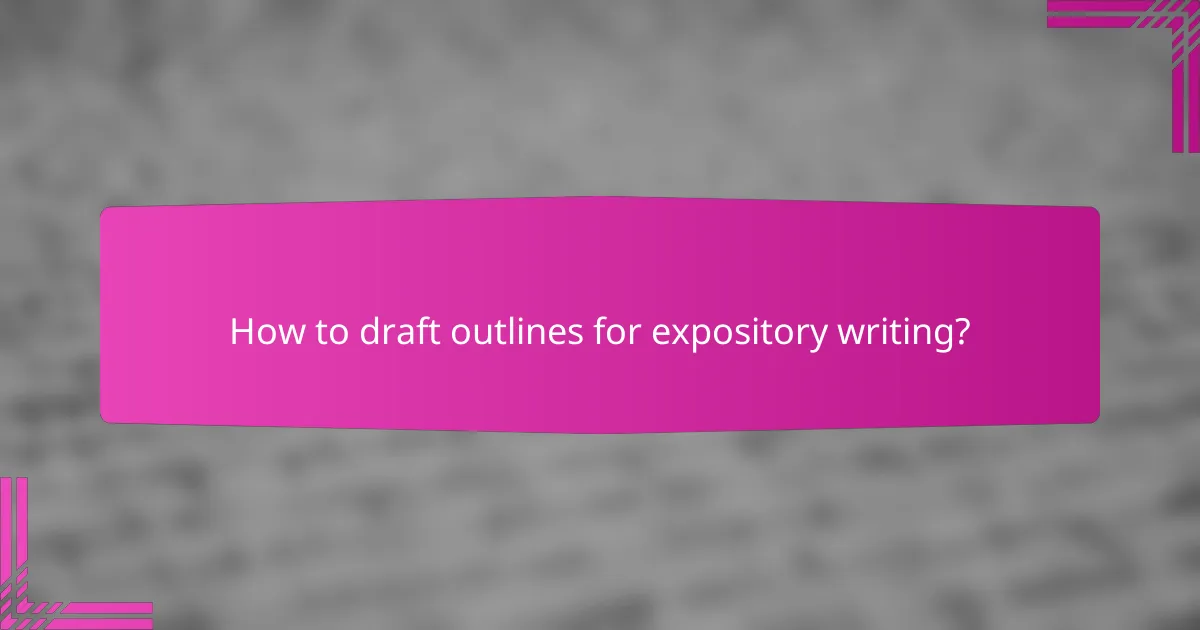
How to draft outlines for expository writing?
Drafting outlines for expository writing involves organizing your main ideas and supporting details in a clear, structured format. This process helps ensure that your writing is coherent and effectively communicates your message.
Follow a structured format
Using a structured format for your outline is essential for clarity and organization. Start with a title that reflects your topic, followed by an introduction, body sections, and a conclusion. Each section should be clearly labeled to guide the reader through your argument or explanation.
A common approach is to use a hierarchical structure, where main ideas are numbered or lettered, and supporting details are indented beneath them. For example:
- 1. Main Idea
- a. Supporting Detail
- b. Supporting Detail
Incorporate main ideas and supporting details
Identifying main ideas and supporting details is crucial for a comprehensive outline. Main ideas serve as the backbone of your writing, while supporting details provide evidence or examples that reinforce these ideas. Aim for a balance between the two, ensuring that each main idea has sufficient support.
For instance, if your main idea is about the benefits of renewable energy, supporting details could include statistics on energy savings, environmental impact, and case studies from various countries. This approach not only strengthens your argument but also makes your writing more persuasive.
Use bullet points for clarity
Bullet points enhance the clarity of your outline by breaking down complex information into digestible pieces. They allow you to present ideas succinctly, making it easier for both you and your readers to follow the flow of your writing.
When using bullet points, keep them concise and focused. Each point should convey a single idea or fact. For example:
- Cost savings from renewable energy
- Reduction in greenhouse gas emissions
- Job creation in the green sector
This format not only aids in organizing your thoughts but also serves as a quick reference during the writing process.
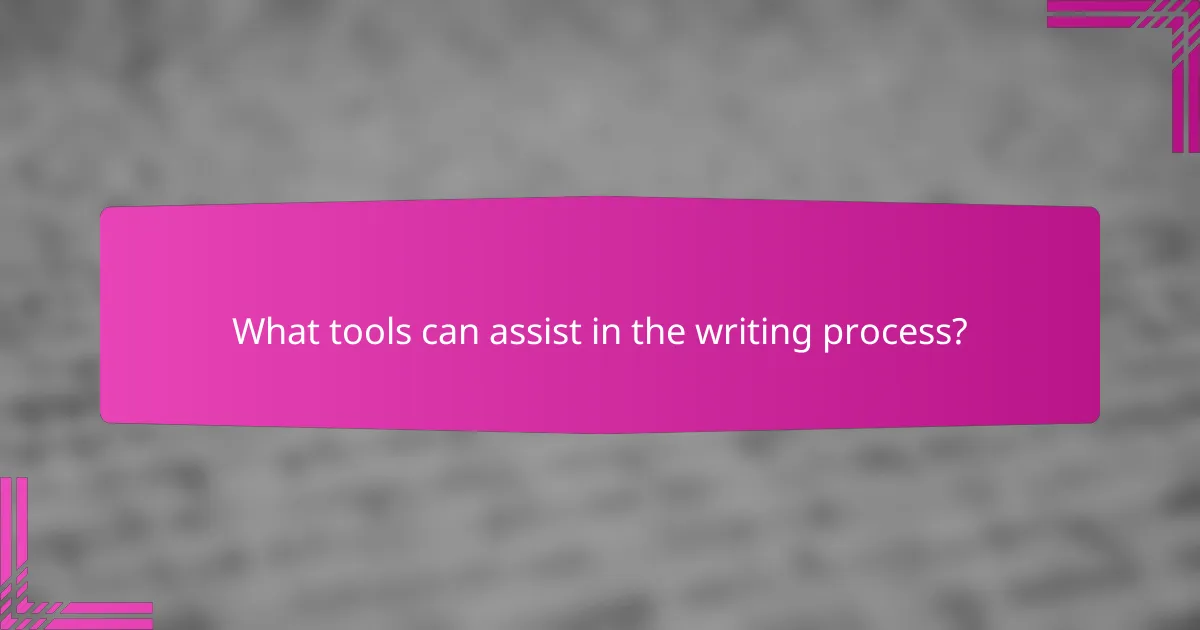
What tools can assist in the writing process?
Several tools can significantly enhance the writing process by aiding in organization, note-taking, and editing. Utilizing the right software can streamline your workflow and improve the quality of your writing.
Scrivener for organization
Scrivener is a powerful tool designed specifically for writers, allowing for easy organization of complex documents. It provides a flexible structure where you can break your work into manageable sections, making it easier to rearrange content as needed.
With features like a corkboard for visual organization and a built-in research folder, Scrivener helps keep all your materials in one place. This is particularly useful for long-form writing projects, such as novels or academic papers, where maintaining a coherent structure is essential.
Evernote for note-taking
Evernote is an excellent application for capturing and organizing notes efficiently. It allows users to create notes in various formats, including text, images, and audio, which can be tagged and categorized for easy retrieval.
Using Evernote, you can clip articles from the web, jot down ideas on the go, and sync your notes across devices. This versatility makes it a valuable tool for writers who need to gather information and inspiration from multiple sources.
Grammarly for editing
Grammarly is a widely used editing tool that helps improve writing quality by checking for grammar, punctuation, and style issues. It provides real-time feedback, allowing writers to make corrections as they draft their work.
In addition to basic grammar checks, Grammarly offers suggestions for enhancing clarity and engagement, making it suitable for both casual and professional writing. By integrating it into your writing process, you can catch errors early and refine your text before finalizing it.

What criteria should be considered when selecting topics?
Selecting topics requires careful consideration of several criteria to ensure they resonate with your audience. Key factors include relevance to audience interests, availability of resources, and potential for engagement.
Relevance to audience interests
Choosing a topic that aligns with your audience’s interests is crucial for capturing their attention. Conduct surveys or analyze existing data to identify what subjects resonate most with your target demographic.
Consider current trends and popular discussions within your niche. For example, if your audience is primarily young professionals, topics related to career development or work-life balance may be particularly engaging.
Availability of resources
Assessing the availability of resources is essential for thorough research and content creation. Ensure that you have access to credible sources, data, and expert opinions to support your topic.
Utilize libraries, academic databases, and online platforms to gather information. If resources are scarce, it may be wise to pivot to a more accessible topic that still meets audience needs.
Potential for engagement
Evaluate the potential for engagement by considering how the topic can spark discussions or encourage interaction. Topics that invite opinions, questions, or personal experiences tend to generate more engagement.
For instance, subjects like “work-from-home strategies” or “sustainable living practices” often lead to lively conversations. Aim for topics that not only inform but also inspire your audience to share their thoughts and experiences.

How to evaluate the credibility of sources?
To evaluate the credibility of sources, consider the author’s qualifications, the publication’s reputation, and the presence of supporting evidence. Reliable sources typically come from experts in the field and are published by reputable organizations.
Check author qualifications
Assessing the author’s qualifications is crucial in determining the credibility of a source. Look for their educational background, professional experience, and any relevant certifications. An author with a PhD in a specific field or extensive experience in a particular industry is generally more credible than someone without such credentials.
Additionally, consider the author’s previous work and contributions to the field. If they have published articles in respected journals or have been cited by other experts, this can enhance their credibility. Always check if the author is affiliated with a reputable institution or organization.
